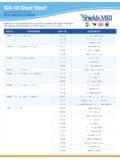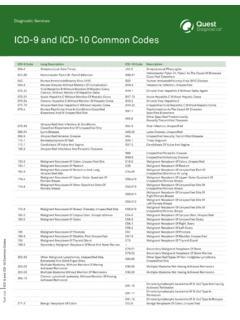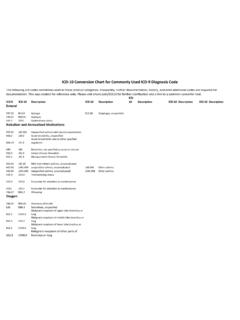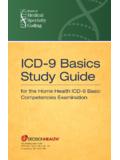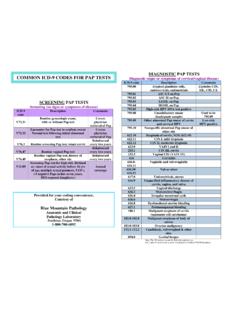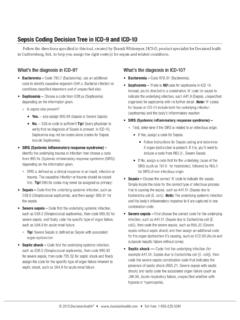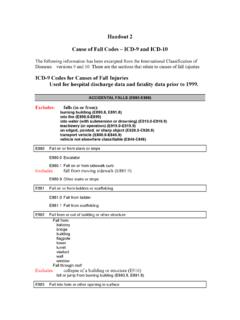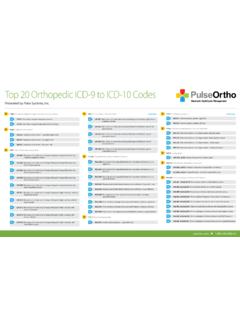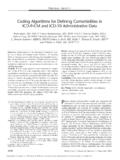Transcription of Chapter 9. CDT Code to ICD (Diagnosis) Code Cross- Walk
1 Chapter 9. CDT Code to ICD (Diagnosis) Code Cross- Walk Introduction Dentists, through education and experience, diagnose a patient s oral health prior to treatment plan preparation and delivery of necessary dental services. However, for diagnoses, codified clinical documentation or reporting on a dental claim is not a routine activity. Change is afoot and your colleagues on the ADA Council on Dental Benefit Programs offer a look ahead to help you prepare for documenting and reporting diagnosis codes if and when required. Both the ADA Dental Claim Form (2012 American Dental Association) and the HIPAA standard electronic dental claim transaction (837D v5010) are able to report up to four diagnosis codes. This capability was added to the claim forms with the expectation that ICD (International Classification of Diseases) would, at some point, become a required data element for dental claim adjudication.
2 Question Why should dentists be concerned with ICD codes when the ADA has developed SNODENT? SNODENT is a clinical terminology designed for use with electronic health records, and it differs from ICD in three ways 1) it is an input code set; 2) it has broader scope and specificity; and 3) it may be mapped to ICD as needed on a dental claim. Federal regulations published under the auspices of HIPAA s Administrative Simplification provisions specify only ICD codes as valid on claim submissions. Hence, this Chapter s focus is ICD. Most diagnoses will be reported using an entry from the Diseases of Oral in ICD-10-CM (K00 K14 series; see Chapter s Appendix for complete list). ICD-10-CM became the HIPAA standard on October 1, 2015, and it is a code set maintained by federal government agencies and available online at no cost.
3 Full file download: Go to heading Downloads and select the calendar year code tables and index ( , 2015 Code Tables and Index - Updated 11/13/14 [ZIP, 16MB]). The downloaded zip file includes ICD-10-CM codes for Diseases and Disorders in: 1) alphabetic order A-Z ( ); and 2) numeric order A00-Z99 ( ). Dentists and their staff are urged to familiarize themselves with the particulars of patients dental benefits plans claim preparation and submission requirements. In addition, pay close attention to communications from dental plans regarding additional benefits for services connected to systemic health or about dental plans intentions to require diagnostic codes on dental claim submissions. SPECIAL NOTE: There is no immediate and universal mandate to include an ICD-10- CM code on all dental claims.
4 We emphasize that not all dental benefit plans will require reporting diagnostic codes. You should check with the plan about its diagnostic code reporting requirements. This Chapter simply augments the information within the CDT Companion to help dentists prepare for future documentation requirements. Dental Procedure Codes (CDT) and Diagnosis Codes (ICD) The following tables link frequently reported CDT codes with one or more possible ICD-10-CM diagnosis codes. Please note that these tables, and especially their linkages, are not all inclusive but simply serve as a guide for commonly occurring conditions. Dentists, by virtue of their clinical education, experience and professional ethics, are the individuals responsible for patient diagnosis. As such a dentist is also obligated to select the appropriate diagnosis code for patient records and claim submission.
5 With experience it is quite possible that the diagnosis will be documented using other ICD-10-CM codes. As you study these tables please note: 1. Some address a single CDT Code ( , sealant), and others include a suite of related ( , restorative) procedure codes. 2. Several contain suggested diagnosis codes that are not from the Diseases of the Oral section ICD-10-CM; there are circumstances ( , vehicle accidents; workers compensation) where other sections of the ICD code set has pertinent entries. 3. Some ICD code terms contain words that are not commonly used in the US. These words, identified by an asterisk (*), are defined in the ADA online glossary 4. In some instances, commonly used CDT codes have not been linked to diagnosis codes. , oral evaluations and diagnostic imaging are not mapped to ICD codes since these services are performed to enable diagnosis of the patient s clinical condition.
6 5. This Chapter is CDT Companion content that is subject to change in response to CDT Code maintenance and ICD Code maintenance. CDT Code(s) D0120 periodic oral evaluation - established patient D0140 limited oral evaluation - problem focused D0150 comprehensive oral evaluation - new or established patient D0210 intraoral complete series of radiographic images D0220 intraoral periapical first radiographic image D0230 intraoral periapical each additional radiographic image D0251 extra-oral posterior dental radiographic image D0272 bitewings two radiographic images D0274 bitewings four radiographic images D0330 panoramic radiographic image D0999 unspecified diagnostic procedure, by report Suggested ICD-10-CM Diagnosis Code(s) Encounter for dental examination and cleaning without abnormal findings Encounter for dental examination and cleaning with abnormal findings CDT Code(s) D1110 prophylaxis adult D1120 prophylaxis child Suggested ICD-10-CM Diagnosis Code(s) Type 2 diabetes mellitus without complications Deposits [accretions] on teeth Chronic gingivitis Chronic gingivitis; plaque induced Chronic periodontitis Tobacco Use Pregnant state.
7 Incidental Encounter for screening for dental disorders CDT Code(s) D1206 topical application of fluoride varnish D1208 topical application of fluoride, excluding varnish Suggested ICD-10-CM Diagnosis Code(s) Arrested dental caries Dental caries on smooth surface limited to enamel Dental root caries Abrasion of teeth Erosion of teeth Sicca syndrome; unspecified Encounter for screening for dental disorders CDT Code(s) D1330 oral hygiene instructions Suggested ICD-10-CM Diagnosis Code(s) Type 2 diabetes mellitus without complications Arrested dental caries Dental caries on pit and fissure surface penetrating into dentine Dental caries limited to enamel Dental caries on smooth surface penetrating into dentine Dental caries of root surface Dental caries; unspecified Erosion of teeth Other periodontal diseases Sicca syndrome; unspecified Anosmia Parosmia Parageusia Pregnant state.
8 Incidental CDT Code(s) D1351 sealant - per tooth D1354 interim caries arresting medicament application D2990 resin infiltration of incipient smooth surface lesions Suggested ICD-10-CM Diagnosis Code(s) Dental caries on pit and fissure surface limited to enamel Dental caries on smooth surface limited to enamel Sicca syndrome*; unspecified Encounter for screening for dental disorders * also known as Sj gren s Syndrome CDT Code(s) D2140 amalgam - one surface; primary or permanent D2150 amalgam - two surfaces; primary or permanent D2160 amalgam - three surfaces; primary or permanent D2161 amalgam - four or more surfaces; primary or permanent Suggested ICD-10-CM Diagnosis Code(s) Dental caries on pit and fissure surface limited to enamel Dental caries on pit and fissure surface penetrating into dentin Dental caries on smooth surface limited to enamel Dental caries on smooth surface penetrating into dentin Cracked tooth Fracture of tooth (traumatic); initial encounter for closed fracture CDT Code(s) D1352 preventive resin restoration Suggested ICD-10-CM Diagnosis Code(s) Dental caries on pit and fissure surface limited to enamel CDT Code(s) D2330 resin-based composite - one surface; anterior D2331 resin-based composite - two surfaces; anterior D2332 resin-based composite - three surfaces.
9 Anterior D2335 resin-based composite - four or more surfaces or involving incisal angle (anterior) Suggested ICD-10-CM Diagnosis Code(s) Abnormalities of size and form of teeth Dental caries on pit and fissure surface limited to enamel Dental caries on pit and fissure surface penetrating into dentin Dental caries on smooth surface limited to enamel Dental caries on smooth surface penetrating into dentin Abrasion of teeth Erosion of teeth Cracked tooth Fracture of tooth (traumatic); initial encounter for closed fracture CDT Code(s) D2391 resin-based composite - one surface; posterior D2392 resin-based composite - two surfaces; posterior D2393 resin-based composite - three surfaces; posterior D2394 resin-based composite - four or more surfaces; posterior Suggested ICD-10-CM Diagnosis Code(s) Dental caries on pit and fissure surface limited to enamel Dental caries on pit and fissure surface penetrating into dentin Dental caries on smooth surface limited to enamel Dental caries on smooth surface penetrating into dentin Dental root caries Abrasion of teeth Erosion of teeth Cracked tooth Fracture of tooth (traumatic).
10 Initial encounter for closed fracture CDT Code(s) D2740 crown - porcelain/ceramic substrate D2750 crown - porcelain fused to high noble metal D2751 crown - porcelain fused to predominantly base metal D2752 crown - porcelain fused to noble metal D2790 crown - full cast high noble metal D2792 crown - full cast noble metal D2950 core buildup; including any pins when required D2951 pin retention - per tooth; in addition to restoration D2952 post and core in addition to crown; indirectly fabricated D2954 prefabricated post and core in addition to crown Suggested ICD-10-CM Diagnosis Code(s) Abnormalities of size and form of teeth Dental caries on pit and fissure surface penetrating into dentin Dental caries on pit and fissure surface penetrating into pulp Dental caries on smooth surface penetrating into dentin Dental caries on smooth surface penetrating into pulp Fracture of tooth (traumatic).
